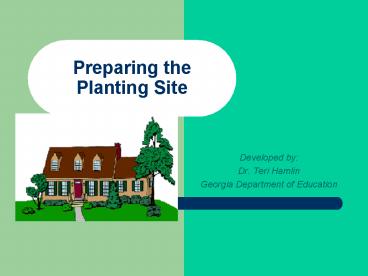Preparing the Planting Site PowerPoint PPT Presentation
1 / 28
Title: Preparing the Planting Site
1
Preparing the Planting Site
- Developed by
- Dr. Teri Hamlin
- Georgia Department of Education
2
Basic Steps
- Whether you're growing flowers, vegetables,
shrubs or trees, the basic steps for preparing
the beds for planting are similar - 1. Site Analysis
- 2. Laying Out New Beds
- 3. Removing Sod/Weeds
- 4. Preparing Soil
- 5. Finishing Borders
3
Site Analysis
- Know your site above and below the ground
- There are three main planting site
characteristics that will influence how plants
will thrive - These three characteristics are
- Soil type and condition
- Drainage
- Availability of light
4
Below the Ground Soil Type
- Three Basic Soil Types
- Sand soils - have easily detectable particles
and are gritty in texture water retention is
very poor, and they are more resistant to
compaction and have minimal nutrient value.Loam
soils - have relatively equal proportions of
sand, silt and clay feel smooth but there is
evidence of graininess have some nutrient value,
and have fair to good moisture retention.Clay
soils - have very fine particles, smooth texture,
retard the movement of water, contain high
nutrient value and compact easily when wet
5
Native Soil vs Desirable Soil
- pH
- Texture
- Drainage
- Fertile
6
Below the Ground Soil Texture
- Fine Texture Clay
- compact
- poorly drained
- low oxygen
- 1 cause of plant decline in Georgia
7
Below the Ground Soil Test
8
Soil pH
- pH governs the availability of nutrients
activity level of microorganisms
9
Below the Ground Soil pH
- Most plants can grow in a soil pH 5.5 - 7.0
- Low pH lt than 5.0 (acidic soil)
- Dolomite or Limestone
- High pH gt 7.0 (alkaline soil)
- Ammonium sulfate , Aluminum sulfate, Sulfuric acid
10
Below the Ground Soil Drainage
Good Drainage water drains in 2 hours Fair
Drainage water drains in several hours Poor
Drainage 8-10 hours water still there
11
Above the GroundSITE ANALYSIS
- Sun Exposure
- Full sun
- Part sun
- Part shade
- Shade
12
Above the GroundWind Flow
- Wind
- increase the amount of water loss from plants
- big problem if root space is limited or poorly
drained soil (lack of root development)
13
Laying Out New Beds
- A garden hose is often the best tool for
establishing the new boundaries - First, lay it out approximately where you want
it. - Then, flex the hose as needed to achieve the
best-looking layout.
14
Laying Out New Beds
- If you're working off a plan and exact dimensions
are critical - Choose a landmark on the plan (like a corner of
the house or lot) - Determine the lengths at right angles from that
to the bed's boundaries on the plan - Measure those same lengths off the landmark in
your yard - Lay the hose through those points to get the
boundaries exact.
15
Removing Present Vegetation
- Once you've determined the boundaries for the
beds, you can remove the sod or whatever
vegetation falls within the boundaries
- Chemically Post Emergence Herbicide
16
Removing Sod
- First, cut into the sod down to the soil along
your boundary line using a square-nose shovel. - Next, use the shovel to pry up the edge of the
sod down to the soil and push the shovel in
between the sod and the soil as level as you can
get it to cut the sod away.
17
Sod Cutter
- For larger beds, a gas operated sod cutter can be
used - Front blade slices the sod away from the soil
18
Preparing Soil
- Area should be turned and dug to a minimum depth
of 12 inches and minimum width of 3x the canopy
19
Amend the soil
- Organic Materials Improve Drainage
- Till 4 to 6 inches of decomposed materials into
the entire planting area to a depth of 12 inches
20
Types of Organic Materials
- Decomposed
- Animal Manure
- Bark
- Peat Moss
- Grass Clippings
- Leaves
- Wood Chips
- Sewage Sludge
21
Compost an Organic Material
22
Elevate Beds
- Increase drainage
- Decrease soil compaction
- 30 greater growth
23
Soil Sample and Analysis
- Determining the fertility level of a soil through
a soil test is the first step in planning a sound
lime and fertilization program for the home
landscape and garden.
24
Lime Fertilizer Recommendations
- Based on your soil sample analysis add needed
lime and nutrients to site.
25
Finishing the Borders
- For a simple, natural look, you can finish your
new beds with a beveled edge. - Just dig down along the edge about 4 inches deep,
pushing the soil back into the bed and leaving a
gap between the bed and the edge. - Then shape the soil so it slopes down to the
bottom of the new edge at a 45 degree angle.
26
Install Edging
- Dig down about 6 inches along the edge of the
bed, keeping the outside edge fairly plumb. - Set the edging against that outside edge.
- Backfill the loose soil against the edging.
- Compact the soil to embed the edging firmly.
- Concrete curbing can be laid by machine
27
Definition of Bed
- If you use edging material or not, show a
definition between lawn and bed.
28
Ready to Plant

